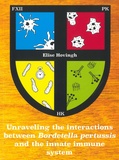Unraveling the interactions between Bordetella pertussis and the innate immune system

Hovingh, Elise
- Promoter:
- Prof.dr. J.A.G. (Jos) van Strijp
- Co-promoter:
- Dr. E. (Elena) Pinelli & dr. I. (Ilse) Jongerius
- Date:
- May 3, 2018
- Time:
- 14:30 h
Summary
Whooping cough, also known as pertussis, is a disease of the respiratory tract that is caused by the Gram-negative bacterium Bordetella pertussis. Pertussis can be life threatening in unvaccinated infants and causes significant morbidity across all age groups. Whole cell pertussis vaccines (WCVs) were introduced in the 1950’s and resulted in a major decrease in pertussis incidence and related mortality. However, due to the adverse events associated with the WCVs, they were replaced with safer acellular pertussis vaccines (ACVs). Despite high vaccination coverage, pertussis has been reemerging and it has become clear that improved pertussis vaccines are needed. Moreover, there is no defined correlate of protection (CoP) against pertussis. This is necessary for the evaluation of pertussis vaccine efficacy.
One of the possible explanations for the reemergence of pertussis is pathogen adaptation. Understanding the effect that changes in the B. pertussis population have on the host immune responses, as well as the immune evasion strategies of this pathogen, is important knowledge needed for the development of third generation pertussis vaccines. In this thesis, we have examined the effect of pathogen adaptation on the innate immune response. In vitro findings from these studies indicate that currently circulating B. pertussis strains induce a dominant anti-inflammatory dendritic cell phenotype which may dampen vaccine-induced immunity and thus favor bacteria survival in the infected host. In the last decade, B. pertussis has adapted to no longer produce pertactin (Prn) which is one of the ACV antigens. We made use of B. pertussis Prn-knock-out isogenic strains to study the effect of Prn-deficiency on the immune response. We show that the lack of Prn production by this pathogen results in an increased production of pro-inflammatory cytokines by human dendritic cells and in mice in an increased expression of genes involved in cell death. This indicates an immunomodulatory role for the vaccine antigen Prn. Another observed adaptation of B. pertussis is the increased production of virulence associated gene 8 (Vag8) by currently circulating strains compared to older strains that circulated before the introduction of the ACV. In this thesis, we unraveled the molecular mechanism of Vag8-mediated complement evasion by B. pertussis. This was mediated by Vag8 binding to the complement regulator C1 inhibitor resulting in the release of active complement proteases in the bacterial surroundings which degraded essential complement proteins. C1 inhibitor also regulates the contact system and we have shown that the production of Vag8 by B. pertussis is needed to activate this system. Finally, in attempt to identify a CoP against pertussis, we investigated opsonophagocytosis of B. pertussis and showed that antibodies specific for filamentous hemagglutinin followed by pertussis toxin are most predictive for opsonophagocytosis.
The research described in this thesis illustrates the interactions between the innate immune system and B. pertussis within the scope of pertussis reemergence. We have shown that pathogen adaptation, accelerated by the introduction of vaccination, has an impact on the activation of innate immune receptors and cells. Moreover, findings from these studies highlight the importance of considering the immunomodulatory properties of (potential) vaccine antigens. Finally, we propose opsonophagocytosis of B. pertussis as a potential CoP against pertussis. Knowledge on B. pertussis host-pathogen interactions is important towards the development of novel third generation pertussis vaccines that are essential to control the reemergence of this highly contagious disease.